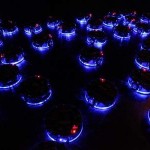Martijn ten Bhömer, Christoph Bartneck, Jun Hu, Rene Ahn, Tuyls, Karl, Frank Delbressine, and Loe Feijs
Abstract – Lego Mindstorms NXT is a platform highly suitable for prototyping in the field of interactive social robotics. During a technology masterclass at Eindhoven University of Technology students from the department of Industrial Design have developed five novel extensions (sensors and actuators) for the Lego Mindstorms NXT which extend the ability of Lego to prototype for robotics even further. Applications include a water-pump, GPS sensor, wireless sensor bridge, optical mouse sensor and a magnetic grabber. In this paper we will present these extensions and showcase applications in which these extend possibilities of Lego Mindstorms NXT to a new level.
Keywords: robot, Lego, Mindstorms, NXT, social, prototyping
M. t. Bhomer, C. Bartneck, J. Hu, R. Ahn, K. Tuyls, F. Delbressine, and L. Feijs, “Developing Novel Extensions to Support Prototyping for Interactive Social Robots,” in 21st Benelux Conference on Artificial Intelligence (BNAIC 2009), Eindhoven, The Netherlands, 2009, pp. 11-17.
FULLTEXT:
PDF HTML REFERENCE:
BibTeX EndNote
 Tom’s Guide published an article by Paul Escallier, in which the AdMoVeo is featured as one of the “30 Inventions From Regular Guys”. We are happy to see that AdMoVeo is getting more attention, although we are listed as “regular guys” 🙂
Tom’s Guide published an article by Paul Escallier, in which the AdMoVeo is featured as one of the “30 Inventions From Regular Guys”. We are happy to see that AdMoVeo is getting more attention, although we are listed as “regular guys” 🙂